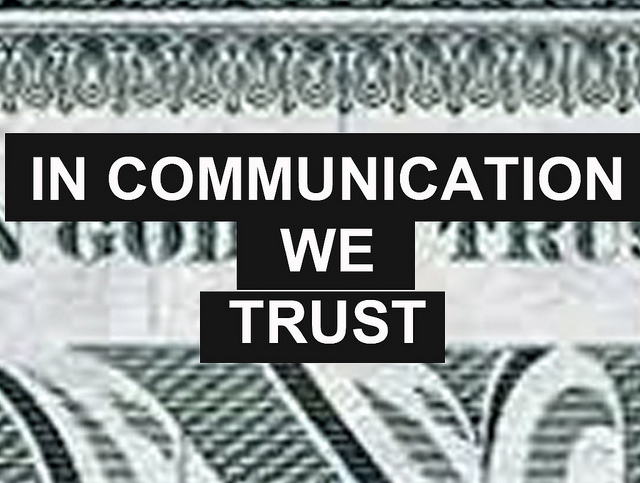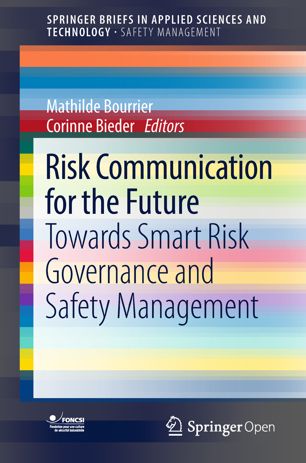Risk communication 3.0: Effect of risk communication on safety management. Who’s minding the store?
Risk communication involves people in a variety of situations in life: parents, children, legislative representatives, regulators, scientists, experts, farmers, communities, designers and sellers of consumer goods, public health officials, managers, supervisors, factory workers, and doctors. Basically, everyone is concerned with risk communication.
Over the last 50 years, it has been the subject of much professionalization: risk communicators have their schools, training courses, manuals and special forums where they exchange on principles, practices, messages, goals and efficiency.
 Traditionally, three
main areas have been subjects of risk communication: the Environment, “Industrial” Safety and Public
Health [Benett & Calman 1999]. It includes the operations and activities of any organization that is
concerned with risk communication, as well as its products and services to consumers and publics at
large. Here again, manuals (see for example [Lundgren & McMakin 2013]) distinguish between three
forms of communication: Care communication; Consensus communication; Crisis communication.
Traditionally, three
main areas have been subjects of risk communication: the Environment, “Industrial” Safety and Public
Health [Benett & Calman 1999]. It includes the operations and activities of any organization that is
concerned with risk communication, as well as its products and services to consumers and publics at
large. Here again, manuals (see for example [Lundgren & McMakin 2013]) distinguish between three
forms of communication: Care communication; Consensus communication; Crisis communication.
Risk communication is considered to be an essential pillar in safety and risk science. Yet, in many cases, it has been reduced to a set of practices and how-to guidelines (dos and Don’ts) that have hampered this essential part of any safety and risk mitigation strategy in getting the attention that it requires.
This workshop will offer a richer perspective on the topic through a reflection on the underlying assumptions and intentions that are behind any attempt at “communicating” about risks and safety matters:
-
outside, but also inside an organization. Indeed, risk communication is not only a question of publics and/or consumers considered to be outside the organization, it is also and (often) more importantly a question of communicating inside the organization
-
during a crisis or in quieter times
-
whether the risks at stake are health, safety, environmental or other nature of risks (reputational for example; including e-reputation)
As an illustration, the recent Ebola outbreak’s management in West Africa brought once again to light the crucial role of risk communication and its limitations when only understood as a one-way communication from “experts” to communities. It is only recently that Public Health Agencies and notably the World Health Organization are now moving from “classic” “Risk Communication” to “Social mobilization” and “engaging with communities” in order to signal what needs to be done when communicating and when being trusted is a life and death issue for people and health care givers jointly.
In a different domain, but still in a crisis context, the Fukushima tragedy gives us another example of a complex and yet essential risk communication strategy, that had to be put in place, and transformed over the months to address the massive problems that had to be tackled by actors within the nuclear industry, communities at risk, general public, government; massive problems that have not vanished and are still pressing.
If risk communication weaknesses often become obvious during crises, it is the overall risk communication concept that needs to be called into question, not only the crisis communication part of it.
In this workshop, we would like to revisit the question of risk communication, and help move from “good old risk communication” to the challenges that today’s world imposes on any risk communication strategy [Collins 2010].
We will discuss the various dimensions of risk communication, how they relate to one another and current challenges. Likewise, we will discuss, based on examples, the areas that are covered, how they are covered and what would be needed to move forward.
We will also reflect on this simple (yet challenging question): Is risk communication a hazardous activity that could possibly do some harm? Maybe. However, if it is the case, it is strangely unregulated [Lofsted et al. 2011]. Or rather lightly regulated: ICAO Annex 13; Nuclear industry? Public Health? The WHO is for the first time pushing for guidance based on evidence-based research on risk communication, trying to move away from the fiascos of recent public health interventions.
Finally, the scope of risk communication is huge and multi-faceted and opens up a variety of questions. Only some are listed below. This call intends to embrace a number of these topics and angles.
Who communicates to whom and what for?
Within an organization:
-
To the top management to get decisions made to allocate resources to risk management, or to other parts of the organization (power games come into play and mix with risk communication strategies)
-
To specific groups, particularly at risk or in denial of risk (workers; first line responders…)
-
To all groups, to develop and sustain a strong safety culture
From an organization to its stakeholders:
-
To regulators to convince them that risks are controlled and operations can go on or (re)-start and products are safe
-
To shareholders, investors and donors to convince them it is worth supporting
-
To insurers to reduce or re-negotiate premiums
-
To the public to build trust and/or get buy-in, or to use their products safely
From the public
-
To look for guidance
-
To challenge an organization/industry: advocacy
-
To experts, to let them know that it also contributes to any risk definition and profile
When to communicate about risks, what and what for?
At ‘normal’ times to do all that was mentioned in the previous section.
During times of crisis: to do damage control. It is not, or should not be the first communication about risks at that time, nor is it the appropriate time to build trust or get buy-in if the foundations are not there. Yet, as the Fukushima and Ebola examples have demonstrated, even in those terrible moments, risk communication has to take place, or rather what will be known from now on as “engagement with communities” has to be undertaken rather quickly.
What is the content of a risk communication strategy?
-
Who’s in charge of what needs to be said, conveyed, shared?
-
Who’s not in charge but communicates nevertheless?
-
What type of knowledge is important to share? What type of doubts is it important to share?
-
What are the benefits and the limitations of sharing some contents?
-
What is the architecture of knowledge inside the organization? How is it mirrored outside the organization?
Evolution of the (risk communication) landscape
-
New stakeholders with social media: silent ambassadors, real experts not formally declared or identified as such.
-
Lobbyists can be more anonymous than in the past where they were limited in number (experts, journalists…)
-
Lots of people to check the validity of a piece of information posted on the internet or social media while at the same time, the same information is reused by many without being checked and validated (race against time)
-
Evolution of the sources of information (number, types, validity)
-
Always quicker at public level (not the case within organizations: workers learn from the press things that are currently happening inside their organization)
-
Evolution of validation loops for organizations or institutions: with social media, the world of real-time communication [Elvers 2009].
-
The key question of trust both within an organization and at a wider level, including at a societal level.
Workshop organizers
- Mathilde Bourrier, University of Geneva
- Corinne Bieder, ENAC
Outputs
The position papers presented during the workshop were improved by authors based on discussion in Sorèze, then published as an open access volume in the SpringerBriefs in Safety Management series. The book can be downloaded for free in PDF and ePub formats.
| Title | Risk Communication for the Future: Towards Smart Risk Governance and Safety Management |
| Editors | Mathilde Bourrier and Corinne Bieder |
| Publisher | Springer |
| Year | 2018 |
| ISBN | 978-3319740973 |
Image credit: The People Speak!
